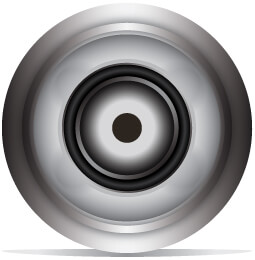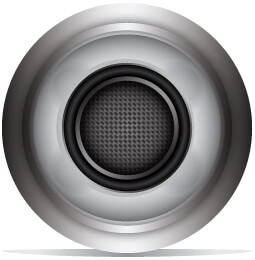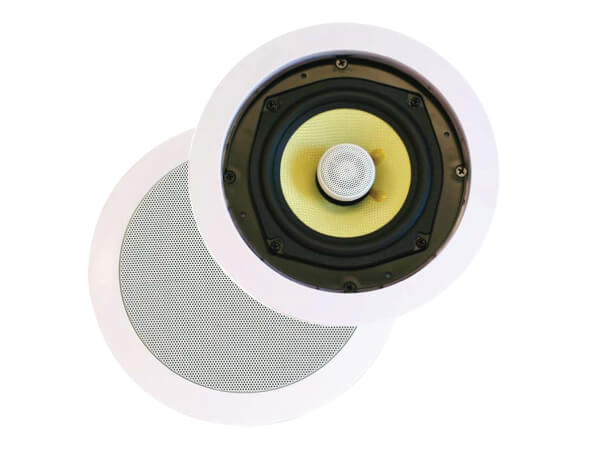You have no items in your shopping cart.
Knowledge Base:
Question: How do I install these speakers in the wall or ceiling?
Answer: There are clips that secure it to the wall or ceiling boards. You don't need any additional box or bracket. You simply cut out a hole in the wall or ceiling with the template provided, insert the speakers and when you turn the mounting screws located on the face of the speakers underneath the grills, the clips will engage and secure the speaker in place.
Question: Can I use these speakers as an LCR (left/center/right) or used a match set for all my surrounds, or is it better to have specific types of speakers for specific locations.
Answer: Opinions will vary even among experts about the proper type of speaker to use. The bottom line is choose what suites your needs and tastes best.
Some of the arguments are as follows:
Using match speakers all around make it a lot easier to match the timber and tonal balance across a sound-stage and around your room. This prevents a character in a movie who walks from one side of the room to another from sounding like Mike Tyson on one side and then James Earl Jones and back to Mike.
On the other hand. Most dialog comes from the center channel of a system in order to anchor the voices to the screen. The human voice tends to represent the upper mid bass frequencies, so dedicated center channels will have dual woofer cones to better produce this range of frequencies. Since dialog can easily be drowned out by ambient noises in the soundtrack, this helps to keep dialog clear and understandable.
Question: There is insulation behind my wall. Is it safe to install the speaker without a box?
Answer: In-wall speakers are designed with the possibility of insulation in mind. The insulation will not harm the speakers or create any hazard. Even regular box speakers have insulation in side them to reduce the effects of standing sound waves.
Question: Can I put an in-wall speaker in the ceiling or an in-ceiling speaker into the wall?
Answer: You can put an in-wall speaker into a ceiling however, because of the mounting depth of the speakers, you can not usually fit an in-ceiling speaker into a wall.
Question: Can these speakers be installed into a suspended ceiling?
Answer: Yes, they can. The usual method would be to use the same suspension wires used to hold the panel frames up to anchor the speaker frames.
Question: How do you set the crossover switch (0, -3db, -6db)?
Answer: The cross over switch allows you to better match the in-wall speakers to the wall you are installing them into by adjusting the roll off between the drivers. Standard non-in-wall speakers come in boxes that are optimized for the speaker and the crossovers are tuned for that specific enclosure. In-wall speakers use the space between the walls as it's enclosure. Since different wall spaces will vary in volume, construction, insulation, etc, a particular in-wall speaker will sound different in different walls. The switch allows you to adjust and optimize the sonic characteristics of the speakers to best match the wall you are installing them into. Set the switch to the setting that gives you the best sounds once they've been installed.
| SKU | 4104 - G1-2 |
|---|---|
| Length (ft) | No |
| Color | No |
| Gauge | No |
| Type of Boot | No |
| Brand | Monoprice |
Lorem Ipsum is simply dummy text of the printing and typesetting industry. Lorem Ipsum has been the industry's standard dummy text ever since the 1500s, when an unknown printer took a galley of type and scrambled it to make a type specimen book. It has survived not only five centuries, but also the leap into electronic typesetting, remaining essentially unchanged. It was popularised in the 1960s with the release of Letraset sheets containing Lorem Ipsum passages, and more recently with desktop publishing software like Aldus PageMaker including versions of Lorem Ipsum.
Lorem Ipsum is simply dummy text of the printing and typesetting industry. Lorem Ipsum has been the industry's standard dummy text ever since the 1500s, when an unknown printer took a galley of type and scrambled it to make a type specimen book. It has survived not only five centuries, but also the leap into electronic typesetting, remaining essentially unchanged. It was popularised in the 1960s with the release of Letraset sheets containing Lorem Ipsum passages, and more recently with desktop publishing software like Aldus PageMaker including versions of Lorem Ipsum.












